Magpie
lab constructor
    
Posts: 5939
Registered: 1-11-2003
Location: USA
Member Is Offline
Mood: Chemistry: the subtle science.
|
|
mauve preparation
After reading Simon Garfield's fascinating book "Mauve: How One Man Invented a Colour That Changed the World," I wanted to make mauve using
Perkin's procedure. Scaccia, Coughlin, and Ball published a paper that provides a microscale procedure for doing this in the Journal of
Scientific Education, vol 75, June, 1998. The procedure was reprinted in Garfield's book.
I used a 10X scale of the procedure which calls for mixing aniline, o-toluidine, and p-toluidine in a mole ratio of 1:1:2, respectively, in water. 2N
H2SO4 is then added to form the sulfate salts, which then dissolve. Oxidation is then accomplished by adding K2Cr2O7. This causes the reactants to
immediately turn black. Further processing consists in washing the tar-like product in water, then petroleum ether. The mauve is then extracted from
the tar residue using methanol.
My first attempt was a failure, which I attribute to poor or partial dissolution of the reactants. The root cause may have been poor quality
p-toluidine, which was self-made. The o-toluidine was also self-made. The aniline, was lab grade but had a rose color. I did not purify it.
On my 2nd try I omitted the p-toluidine since 1) I didn't have anymore, and 2) I found in my reading that I would likely get a mauve with just one
toluidine. This attempt was successful.
The photo below shows the reactants just after dissolution was achieved. Here I used 1/2 of the 2N H2SO4 specified as I was only using 1/2 the moles
of amines specified. This was just enough to give complete dissolution with the aid of warming.
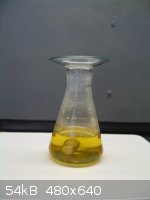
The next photo shows what the reactants look like after addition of the K2Cr2O7 oxidant. This was then stirred at room temperature for 2 hours, per
procedure.
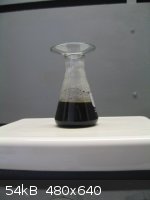
Following this stirring I withdrew a small portion of the tar and added it to some methanol. The solution turned a mauve color right away, as shown
below.
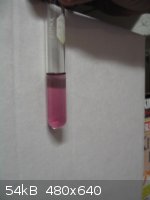
I then Buchner filtered the product keeping only the residue. This was water washed, dried, then washed with petroleum ether. After drying it looked
like this:
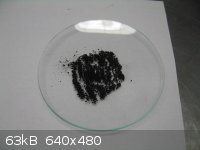
The directions for the extraction of mauve from this dried residue in the Scaccia paper are very confusing. So, instead I merely extracted the
residue with methanol then filtered the extract. This captured the mauve. However, for some reason it has more red in it, looking just like concord
grape juice.
Disscussion There is a lot of information about William Perkin's invention of mauve. Recent studies have shown that there are
several types of mauve. There is a 1994 paper out on the composition of mauve by Meth-Cohn and Smith but I was not able to access it. Two formulae
are shown here:
Attachment: mauve.doc (27kB)
This file has been downloaded 500 times
This synthesis can be tedious; I know it was for me on my first attempt. It amply illustrates the persistence that Perkin showed when he first
isolated mauve. The second time I streamlined it quite a bit. allphysist on versuchschemie.de also found it tedious.
An interesting user-friendly procedure for mauve has been published by Kevin M. Dunn in his book "Caveman Chemistry." It specifies replacing water
with ethanol, H2SO4 with vinegar, and K2Cr2O7 with household bleach (sodium hypochlorite). He claims that it makes no tar. I have not tried it.
Here's the excerpt on mauve:
It has been fun researching this book and trying to figure out how to make things from scratch. Sometimes I have gained inspiration from
modern laboratory manuals, but more often than not, the projects have developed by trying to imagine what commonly-available materials could be used
to make something appropriate to each chapter; this chapter was one of the last ones to "come together." At first I imagined that I would make mauve
as Perkin had done, but the more I learned about Perkin's synthesis, the more discouraged I became. Perkin dissolved his aniline in aqueous sulfuric
acid. Oxidation of this solution with potassium dichromate produced an insoluble brown goo which would have to be filtered, and filtering goo is no
picnic. Once filtered, the goo would be extracted with ethanol, which would dissolve the dye. Perkin's yield was on the order of 5%, that is, 5% dye,
95% useless goo. Could caveman chemists be expected to make such a dye when even experts got such poor yields? Furthermore, chromium compounds pose a
health risk and a disposal problem I was not sure I wanted to impose on beginners. Finally, neither aniline, nor toluidine, nor potassium dichromate
is a household item. It seemed that there was much to be said against mauve as a project.Nevertheless, I wondered whether it might be possible to
substitute a household oxidizing agent for potassium dichromate. Wagner's Chemical Technology of 1872[1] reported that bleaching powder, calcium
hypochlorite, had been used as an alternative to potassium dichromate. I wondered whether sodium hypochlorite, modern laundry bleach, might also do
the trick.I also wondered whether the goo-filtering step might be avoided by performing the oxidation in ethanol rather than aqueous solution. I
expected that the goo might settle to the bottom of the container and the ethanolic dye might simply be poured off. My very first try using laundry
bleach in ethanol took my breath away; it resulted in a rich purple dye and no goo at all. Not only did the household chemical work, it apparently
worked better than any combination I had found in the chemical literature! But it was when I applied the dye to some silk cloth that I knew how Perkin
must have felt.To begin with, you need some aniline. If you buy aniline from a chemical supply it will likely be of higher purity than you need. Pure
aniline will produce the brown pseudomauveine which, while it is a perfectly good brown dye, is unlikely to have the visual impact of mauveine. To
make mauveine you need aniline contaminated with o-toluidine and p-toluidine. The optimum proportions are one mole aniline, two moles o-toluidine, and
one mole p-toluidine. Since these three compounds have similar molecular weights and densities, you can make it up as 1 gram of aniline, two of
o-toluidine, and one of p-toluidine. I will refer to this mixture as "aniline oil." The four grams just described will make a lot of dye; in a
classroom situation, this amount of aniline oil will be enough for about a hundred students.You will make two solutions. First measure one mL of white
household vinegar using a graduated pipette or a graduated cylinder. Place the vinegar into a small vial and add 1 drop of aniline oil to it. The oily
aniline will dissolve completely within a minute or two. Now measure 5 mL of ethanol into a graduated cylinder and add 10 drops of bleach to it. Add
the ethanol-bleach solution to the vinegar-aniline solution and put the cap on the vial. The combined solution should immediately turn brown as the
aromatic amines are oxidized. The brown color will turn blue in a few minutes and then purple in an hour or so. This vial of dye is sufficient for
dyeing a 12-inch silk handkerchief.
Dunn says that the aniline/o-toluidine/p-toluidine mole ratio should 1:2:1. This makes more sense as this is more like the ratio one would expect
when forming these amines from benzene and toluene in coal tar, as did Perkin.
Comments, suggestions, and questions are welcomed.
[Edited on 9-4-2014 by Magpie]
The single most important condition for a successful synthesis is good mixing - Nicodem
|
|
|
Zephyr
Hazard to Others
  
Posts: 341
Registered: 30-8-2013
Location: Seattle, WA
Member Is Offline
|
|
Very interesting procedure, how did you make the o-toluidine?
Never mind, I found your thread on its preparation from o-nitrotoluen. Here is that thread.
Also, the cave man chemistry link doesn't work for me...
[Edited on 9-4-2014 by Pinkhippo11]
|
|
|
Magpie
lab constructor
    
Posts: 5939
Registered: 1-11-2003
Location: USA
Member Is Offline
Mood: Chemistry: the subtle science.
|
|
Thanks. I replaced the url with an excerpt from Dunn's book.
The single most important condition for a successful synthesis is good mixing - Nicodem
|
|
|
zed
International Hazard
    
Posts: 2277
Registered: 6-9-2008
Location: Great State of Jefferson, City of Portland
Member Is Offline
Mood: Semi-repentant Sith Lord
|
|
I have concerns about the toxicity of some of the more exotic anilines. Aniline is poisonous, P-Methoxy Aniline, and 2,5-Dimethoxy Aniline, are
probably more toxic. But, how much more toxic? I have tried to research this matter in the past, but information seems to be lacking.
Anybody present have references? Some chemicals are toxic, some chemicals are really, really toxic, and some chemicals are just better to avoid
working with. Hard to know what's what, just from reading the commonly available literature.
|
|
|
PeeWee2000
Hazard to Self
 
Posts: 58
Registered: 2-7-2013
Location: Michigan
Member Is Offline
Mood: No Mood
|
|
Pretty end product, looks great Magpie! Funny how stuff that was first discovered in 1800 can still be a pain, but what fun is a reaction if it works
right on the first time 
And zed just a guess by the lack of information out there but its probably not too extrodinarily toxic if there aren't all that many write ups about
its toxicity seeing as how it was used as a clothing dye and even a food coloring in the early 1900s. But thats just a guess I'm betting its still a
mild carcinogen at the least.
“Everything is relative in this world, where change alone endures.”
― Leon Trotsky
|
|
|
zed
International Hazard
    
Posts: 2277
Registered: 6-9-2008
Location: Great State of Jefferson, City of Portland
Member Is Offline
Mood: Semi-repentant Sith Lord
|
|
Not the toxicity of the mauve itself.... I meant the toxicity of various exotic aniline-type precursors.
|
|
|
Mailinmypocket
International Hazard
    
Posts: 1351
Registered: 12-5-2011
Member Is Offline
Mood: No Mood
|
|
Yesterday I tried the procedure posted by Magpie from "Caveman Chemistry". Instead of making up the "aniline oil" due to lack of o-toluidine an
attempt was made using only aniline, the aniline is dark red, purchased from a laboratory supplier.
A dark brown/red almost black solution was produced. After sitting all day I soaked the entire vial into a wad of cotton and left it to dry in a petri
dish on top of tissue papers. This morning to my surprise there are definite purple/mauve colors on the tissue paper that worked as a crude,
unintentional chromatography paper. The result is pretty and I will re attempt this today using Chromatography paper at different times during the
reaction to monitor the progress.
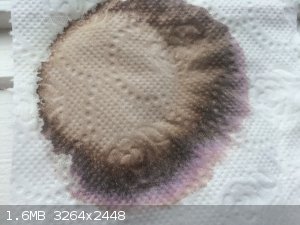
Cutting the purple areas from as much tissue as possible, then rinsing them in methanol gave this solution:
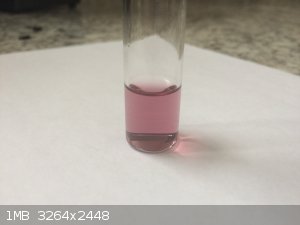 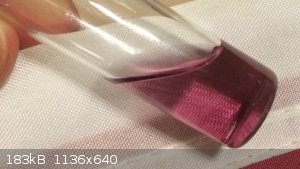
Here are two strips of chromatography paper, for today's attempt. The first was done at the start of the reaction. The second 2 hours later:
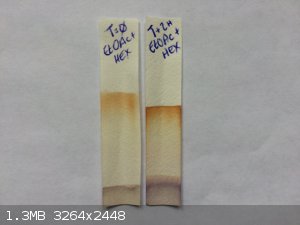
[Edited on 17-1-2015 by Mailinmypocket]
Note to self: Tare the damned flask.
|
|
|
AvBaeyer
National Hazard
   
Posts: 644
Registered: 25-2-2014
Location: CA
Member Is Offline
Mood: No Mood
|
|
Magpie,
Great write up! Takes me back to my basement lab over 50 years ago. I made a lot of dyes, including mauve, during those Minnesota winters.
AvB
|
|
|
CuReUS
National Hazard
   
Posts: 928
Registered: 9-9-2014
Member Is Offline
Mood: No Mood
|
|
magpie,do you have the "Mauve: How One Man Invented a Colour That Changed the World," ebook, if so could you please upload it here
you could try making indigo next
http://en.wikipedia.org/wiki/Baeyer%E2%80%93Drewson_indigo_s...
| Quote: | | Not the toxicity of the mauve itself.... I meant the toxicity of various exotic aniline-type precursors. |
IIRC,there were cases of bladder cancer reported due to mauvine
http://en.wikipedia.org/wiki/Mauveine#History
|
|
|
Magpie
lab constructor
    
Posts: 5939
Registered: 1-11-2003
Location: USA
Member Is Offline
Mood: Chemistry: the subtle science.
|
|
Quote: Originally posted by CuReUS  | magpie,do you have the "Mauve: How One Man Invented a Colour That Changed the World," ebook, if so could you please upload it here
|
No - sorry. I only have a paperback book.
The single most important condition for a successful synthesis is good mixing - Nicodem
|
|
|
AvBaeyer
National Hazard
   
Posts: 644
Registered: 25-2-2014
Location: CA
Member Is Offline
Mood: No Mood
|
|
The book "Mauve: How One Man Invented a Colour That Changed the World," is easily and fairly cheaply available on the ABE Books website. I just
ordered a mint hardbound for $10 including shipping.
Also, anyone interested in dyes and their chemistry/history may be find this site useful:
http://www.colorantshistory.org/home.html
There is much to see there including a long piece about Perkin and dyes.
Finally, a very rare (expensive) book but utterly fascinating regarding the development of the dye industry and the whole field of organic chemistry
is:
Travis, "The Rainbow Makers"
I was able to get this through an interlibrary loan and make a nice photocopy several years ago.
Enjoy,
AvB
|
|
|
Fidelmios
Hazard to Others
  
Posts: 104
Registered: 28-4-2016
Location: Witty Chemistry Joke
Member Is Offline
Mood: No Mood
|
|
Modern Mauveine
Hey all,
Recently I made Prussian Blue and now I'm sorta on a historical dye hunt. Next on the list is Mauve, https://en.m.wikipedia.org/wiki/Mauveine and now I'm here to ask for your help. Are there any sources to help me make this? Is there a way to
repeat this experiment in modern times? Also I'm interested in the cheapest option because while Ramen is cheap, it gets old and I would love to eat
beef some days haha!
|
|
|
NitratedKittens
Hazard to Others
  
Posts: 131
Registered: 13-4-2015
Location: In the basket with all the other kittens
Member Is Offline
Mood: Carbonated
|
|
Try the wiki page you linked to, aniline and toluidine are both things that with some difficulty a home chemist can make, also dichromate and sulfuric
acid are fairly easy to come by.
Basket of kittens for you ........BOOM
|
|
|
Texium
|
Threads Merged
6-1-2017 at 14:16 |
Dr.Bob
International Hazard
    
Posts: 2656
Registered: 26-1-2011
Location: USA - NC
Member Is Offline
Mood: No Mood
|
|
Most anilines will be pink, red or purple due to traces of oxidation products, but that usually is not a problem. They are all somewhat toxic but
not so much as to be horrible, except for a few, the biphenyl, naphthyl, and a few others are more toxic than others. I likely have a book with all
of that info somewhere in my pile, if someone wants one.
Many of these reactions make tars, some black crud can be extracted by Soxhlet or other slow means to slowly dissolve the dye from the tar, I had a
series of reactions of quinolines that required an extraction of the product in ether from the tar and then recrystallization to get the product, but
they worked pretty well and gave colorless products in OK yields in the end. Mixing the goo with celite, silica gel or other stuff can help make it
easier also.
|
|
|
Bedlasky
International Hazard
    
Posts: 1219
Registered: 15-4-2019
Location: Period 5, group 6
Member Is Offline
Mood: Volatile
|
|
Quote: Originally posted by Magpie  |
It has been fun researching this book and trying to figure out how to make things from scratch. Sometimes I have gained inspiration from
modern laboratory manuals, but more often than not, the projects have developed by trying to imagine what commonly-available materials could be used
to make something appropriate to each chapter; this chapter was one of the last ones to "come together." At first I imagined that I would make mauve
as Perkin had done, but the more I learned about Perkin's synthesis, the more discouraged I became. Perkin dissolved his aniline in aqueous sulfuric
acid. Oxidation of this solution with potassium dichromate produced an insoluble brown goo which would have to be filtered, and filtering goo is no
picnic. Once filtered, the goo would be extracted with ethanol, which would dissolve the dye. Perkin's yield was on the order of 5%, that is, 5% dye,
95% useless goo. Could caveman chemists be expected to make such a dye when even experts got such poor yields? Furthermore, chromium compounds pose a
health risk and a disposal problem I was not sure I wanted to impose on beginners. Finally, neither aniline, nor toluidine, nor potassium dichromate
is a household item. It seemed that there was much to be said against mauve as a project.Nevertheless, I wondered whether it might be possible to
substitute a household oxidizing agent for potassium dichromate. Wagner's Chemical Technology of 1872[1] reported that bleaching powder, calcium
hypochlorite, had been used as an alternative to potassium dichromate. I wondered whether sodium hypochlorite, modern laundry bleach, might also do
the trick.I also wondered whether the goo-filtering step might be avoided by performing the oxidation in ethanol rather than aqueous solution. I
expected that the goo might settle to the bottom of the container and the ethanolic dye might simply be poured off. My very first try using laundry
bleach in ethanol took my breath away; it resulted in a rich purple dye and no goo at all. Not only did the household chemical work, it apparently
worked better than any combination I had found in the chemical literature! But it was when I applied the dye to some silk cloth that I knew how Perkin
must have felt.To begin with, you need some aniline. If you buy aniline from a chemical supply it will likely be of higher purity than you need. Pure
aniline will produce the brown pseudomauveine which, while it is a perfectly good brown dye, is unlikely to have the visual impact of mauveine. To
make mauveine you need aniline contaminated with o-toluidine and p-toluidine. The optimum proportions are one mole aniline, two moles o-toluidine, and
one mole p-toluidine. Since these three compounds have similar molecular weights and densities, you can make it up as 1 gram of aniline, two of
o-toluidine, and one of p-toluidine. I will refer to this mixture as "aniline oil." The four grams just described will make a lot of dye; in a
classroom situation, this amount of aniline oil will be enough for about a hundred students.You will make two solutions. First measure one mL of white
household vinegar using a graduated pipette or a graduated cylinder. Place the vinegar into a small vial and add 1 drop of aniline oil to it. The oily
aniline will dissolve completely within a minute or two. Now measure 5 mL of ethanol into a graduated cylinder and add 10 drops of bleach to it. Add
the ethanol-bleach solution to the vinegar-aniline solution and put the cap on the vial. The combined solution should immediately turn brown as the
aromatic amines are oxidized. The brown color will turn blue in a few minutes and then purple in an hour or so. This vial of dye is sufficient for
dyeing a 12-inch silk handkerchief.
Dunn says that the aniline/o-toluidine/p-toluidine mole ratio should 1:2:1. This makes more sense as this is more like the ratio one would expect
when forming these amines from benzene and toluene in coal tar, as did Perkin.
Comments, suggestions, and questions are welcomed.
[Edited on 9-4-2014 by Magpie] |
I tried this method with great success! My first attempt was a failure. I was using ordinary denaturated ethanol. After adding bleach, ethanol turned
immediately brown. And things didn't get better after addition to the aniline oil in 10% acetic acid. Today I tried using MEK free denaturated
ethanol. And this time the reaction works exactly like in that article cited by Magpie. This time ethanol didn't turn brown. Mixing of the two
solutions result in dark blue solution. After one hour I returned to reaction mixture and it was very intensely dark purple - very similar to
permanganate solution. After dilution in MeOH it still look like dilute permanganate. Nice and easy preparation of mauveine.
[Edited on 26-1-2024 by Bedlasky]
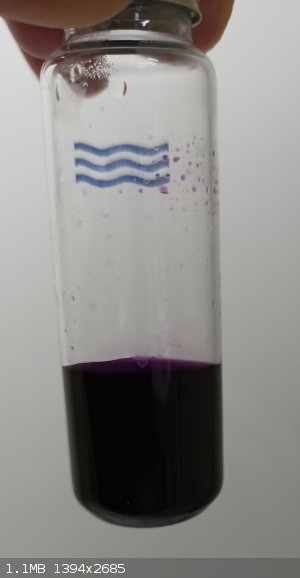 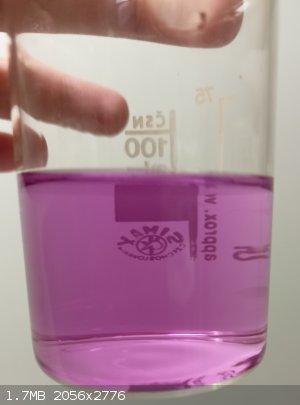 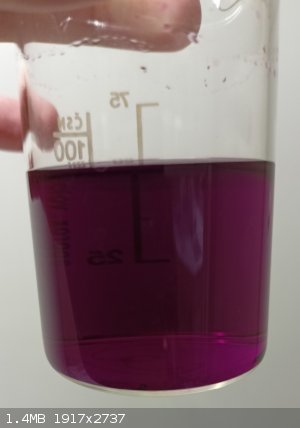
|
|
|
Fery
National Hazard
   
Posts: 990
Registered: 27-8-2019
Location: Czechoslovakia
Member Is Offline
|
|
Great experiment Bedlasky !!! Thanks for sharing all the necessary steps and also to avoid butanone denatured ethanol. I wonder whether the synthesis
could be done in methanol or isopropanol, these alcohols are usually free of MEK. IPA could be oxidized into acetone and cause the same problem as MEK
(haloform reaction with NaOCl so very likely better to use K2Cr2O7 as oxidant then so part of IPA will be oxidized into acetone but no haloform
reaction). The colors you achieved are beautiful.
|
|
|
Ormarion
Hazard to Self
 
Posts: 54
Registered: 19-12-2017
Location: France
Member Is Offline
Mood: Alkylating her DNA
|
|
Very interesting post, i am just wondering if it is indeed mauve and not safranine you made in your first pictures, from my personal experience i know
that reactio is quite tricky and generate both. I personally would rince the "tar" using xylene to remove that safranine and dissolve what is left in
ethanol
After some tries this was the solid i obtained at the end following ethanol evaporation
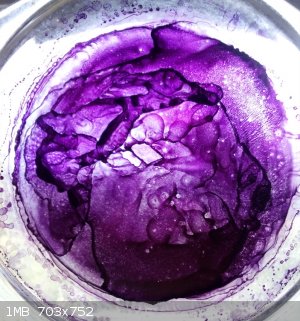
[Edited on 27-1-2024 by Ormarion]
|
|
|